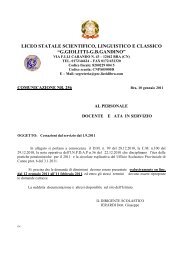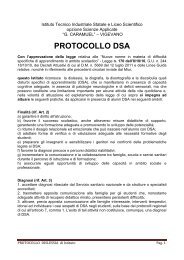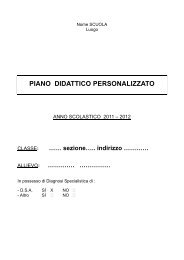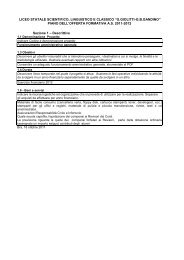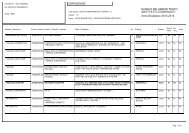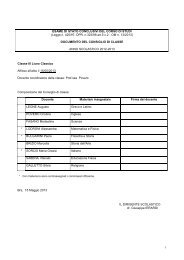Bloom's Taxonomy: Categories in the Cognitive ... - Licei di Bra
Bloom's Taxonomy: Categories in the Cognitive ... - Licei di Bra
Bloom's Taxonomy: Categories in the Cognitive ... - Licei di Bra
Create successful ePaper yourself
Turn your PDF publications into a flip-book with our unique Google optimized e-Paper software.
Design<strong>in</strong>g Effective Projects: Th<strong>in</strong>k<strong>in</strong>g Skills FrameworksBloom’s <strong>Taxonomy</strong>: A New Look at an Old StandbyTra<strong>di</strong>tional Hierarchy of Th<strong>in</strong>k<strong>in</strong>g ProcessesIn 1956, Benjam<strong>in</strong> Bloom wrote <strong>Taxonomy</strong> of Educational Objectives: <strong>Cognitive</strong> Doma<strong>in</strong>, and hissix-level description of th<strong>in</strong>k<strong>in</strong>g has been widely adapted and used <strong>in</strong> countless contexts evers<strong>in</strong>ce. His list of cognitive processes is organized from <strong>the</strong> most simple, <strong>the</strong> recall of knowledge,to <strong>the</strong> most complex, mak<strong>in</strong>g judgments about <strong>the</strong> value and worth of an idea.Bloom’s <strong>Taxonomy</strong> of Educational Objectives (Tra<strong>di</strong>tional)Skill Def<strong>in</strong>ition Key WordsKnowledge Recall <strong>in</strong>formation Identify, describe, name, label,recognize, reproduce, followComprehension Understand <strong>the</strong> mean<strong>in</strong>g, paraphrase aconceptSummarize, convert, defend,paraphrase, <strong>in</strong>terpret, give examplesApplication Use <strong>the</strong> <strong>in</strong>formation or concept <strong>in</strong> a newsituationBuild, make, construct, model, pre<strong>di</strong>ct,prepareAnalysisBreak <strong>in</strong>formation or concepts <strong>in</strong>to parts tounderstand it more fullyCompare/contrast, break down,<strong>di</strong>st<strong>in</strong>guish, select, separateSyn<strong>the</strong>sis Put ideas toge<strong>the</strong>r to form someth<strong>in</strong>g new Categorize, generalize, reconstructEvaluation Make judgments about value Appraise, critique, judge, justify,argue, supportToday’s world is a <strong>di</strong>fferent place, however, than <strong>the</strong> one Bloom’s <strong>Taxonomy</strong> reflected <strong>in</strong> 1956.Educators have learned a great deal more about how students learn and teachers teach and nowrecognize that teach<strong>in</strong>g and learn<strong>in</strong>g encompasses more than just th<strong>in</strong>k<strong>in</strong>g. It also <strong>in</strong>volves <strong>the</strong>feel<strong>in</strong>gs and beliefs of students and teachers as well as <strong>the</strong> social and cultural environment of <strong>the</strong>classroom.Several cognitive psychologists have worked to make <strong>the</strong> basic concept of a taxonomy of th<strong>in</strong>k<strong>in</strong>gskills more relevant and accurate. In develop<strong>in</strong>g his own taxonomy of educational objectives,Marzano (2000) po<strong>in</strong>ts out one criticism of Bloom’s <strong>Taxonomy</strong>. The very structure of <strong>the</strong><strong>Taxonomy</strong>, mov<strong>in</strong>g from <strong>the</strong> simplest level of knowledge to <strong>the</strong> most <strong>di</strong>fficult level of evaluation, isnot supported by research. A hierarchical taxonomy implies that each higher skill is composed of<strong>the</strong> skills beneath it; comprehension requires knowledge; application requires comprehension andknowledge, and so on. This, accord<strong>in</strong>g to Marzano, is simply not true of <strong>the</strong> cognitive processes<strong>in</strong> Bloom’s <strong>Taxonomy</strong>.The orig<strong>in</strong>ators of <strong>the</strong> orig<strong>in</strong>al six th<strong>in</strong>k<strong>in</strong>g processes assumed that complex projects could belabeled as requir<strong>in</strong>g one of <strong>the</strong> processes more than <strong>the</strong> o<strong>the</strong>rs. A task was primarily an “analysis”or an “evaluation” task. This has been proven not to be true which may account for <strong>the</strong> <strong>di</strong>fficultythat educators have classify<strong>in</strong>g challeng<strong>in</strong>g learn<strong>in</strong>g activities us<strong>in</strong>g <strong>the</strong> <strong>Taxonomy</strong>. Anderson(2000) argues that nearly all complex learn<strong>in</strong>g activities require <strong>the</strong> use of several <strong>di</strong>fferentcognitive skills.Like any <strong>the</strong>oretical model, Bloom’s <strong>Taxonomy</strong> has its strengths and weaknesses. Its greateststrength is that it has taken <strong>the</strong> very important topic of th<strong>in</strong>k<strong>in</strong>g and placed a structure around itthat is usable by practitioners. Those teachers who keep a list of question prompts relat<strong>in</strong>g to <strong>the</strong>various levels of Bloom’s <strong>Taxonomy</strong> undoubtedly do a better job of encourag<strong>in</strong>g higher-orderth<strong>in</strong>k<strong>in</strong>g <strong>in</strong> <strong>the</strong>ir students than those who have no such tool. On <strong>the</strong> o<strong>the</strong>r hand, as anyone whohas worked with a group of educators to classify a group of questions and learn<strong>in</strong>g activitiesaccord<strong>in</strong>g to <strong>the</strong> <strong>Taxonomy</strong> can attest, <strong>the</strong>re is little consensus about what seem<strong>in</strong>gly self-evident





